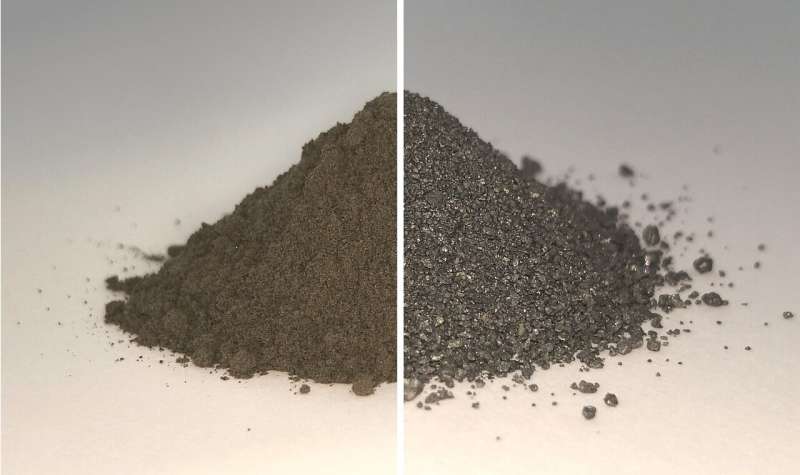Oxygen and metal from lunar regolith

On the left side of this before and after image is a pile of simulated lunar soil, or regolith; on the right is the same pile after essentially all the oxygen has been extracted from it, leaving a mixture of metal alloys. Both the oxygen and metal could be used in future by settlers on the Moon.
Samples returned from the lunar surface confirm that lunar regolith is made up of 40-45 percent percent oxygen by weight, its single most abundant element.
"This oxygen is an extremely valuable resource, but it is chemically bound in the material as oxides in the form of minerals or glass, and is therefore unavailable for immediate use," explains researcher Beth Lomax of the University of Glasgow, whose Ph.D. work is being supported through ESA's Networking and Partnering Initiative, harnessing advanced academic research for space applications.
"This research provides a proof-of-concept that we can extract and utilise all the oxygen from lunar regolith, leaving a potentially useful metallic by-product.
"The processing was performed using a method called molten salt electrolysis. This is the first example of direct powder-to-powder processing of solid lunar regolith simulant that can extract virtually all the oxygen. Alternative methods of lunar oxygen extraction achieve significantly lower yields, or require the regolith to be melted with extreme temperatures of more than 1600°C."
The process involves placing the powdered regolith in a mesh-lined basket with molten calcium chloride salt serving as an electrolyte, heated to 950°C. At this temperature the regolith remains solid.
Passing a current through it causes the oxygen to be extracted from the regolith and migrate across the salt to be collected at an anode. It took 50 hours in all to extract 96 percent of the total oxygen, but 75 percent can be extracted in just the first 15 hours.
Beth adds: "This work is based on the FCC process—from the initials of its Cambridge-based inventors—which has been scaled up by a UK company called Metalysis for commercial metal and alloy production."
"We are working with Metalysis and ESA to translate this industrial process to the lunar context, and the results so far are very promising," notes Mark Symes, Beth's Ph.D. supervisor at the University of Glasgow.
James Carpenter, ESA's lunar strategy officer comments: "This process would give lunar settlers access to oxygen for fuel and life support, as well as a wide range of metal alloys for in-situ manufacturing—the exact feedstock available would depend on where on the Moon they land."
"It could also be used to extract useful materials on Mars as well, where pre-processing the feedstock would give pure metals and alloy products," adds ESA materials engineer Advenit Makaya.
More information: Bethany A. Lomax et al. Proving the viability of an electrochemical process for the simultaneous extraction of oxygen and production of metal alloys from lunar regolith, Planetary and Space Science (2019). DOI: 10.1016/j.pss.2019.104748
Journal information: Planetary and Space Science
Provided by European Space Agency



















